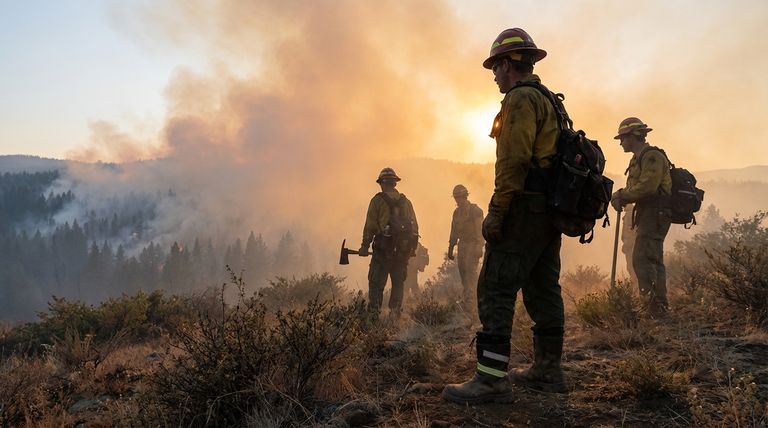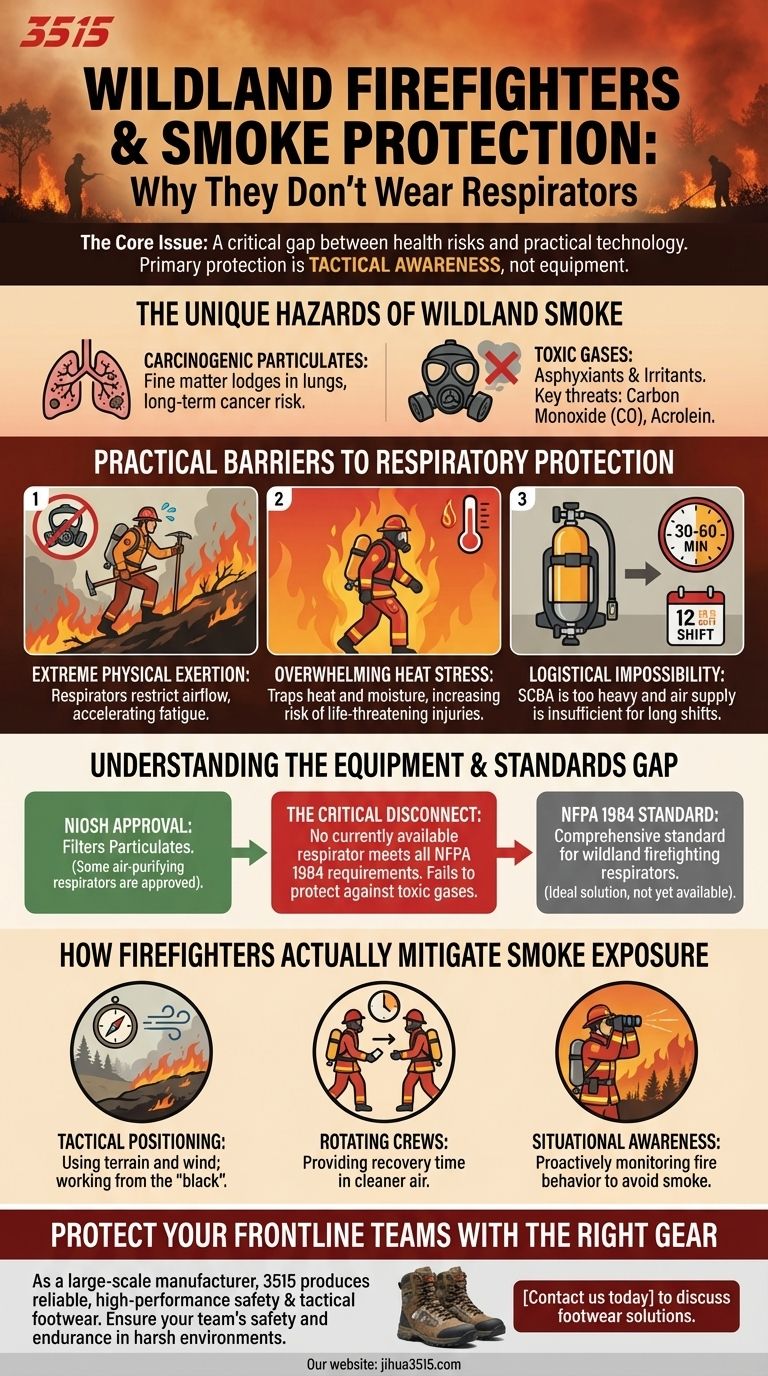In practice, wildland firefighters do not typically wear respirators for smoke protection. While some NIOSH-approved respirators exist, none currently meet the comprehensive safety standard (NFPA 1984) for wildland firefighting. The extreme physical demands and heat of the environment make most respiratory protection, which can be hot and bulky, impractical and potentially dangerous to wear during active fire suppression.
The core issue is a critical gap between the known long-term health risks of smoke inhalation and the practical limitations of current respiratory technology. The primary method of protection is not a piece of equipment, but tactical and situational awareness to minimize exposure.

The Unique Hazards of Wildland Smoke
Wildland fire smoke is a complex mixture of particulates and toxic gases that poses significant health risks. Understanding these components is key to understanding the limitations of any protective equipment.
Carcinogenic Particulates
The most visible component of smoke, fine particulate matter, can lodge deep in the lungs. Many of these particles are carcinogenic, contributing to the long-term cancer risk faced by firefighters.
Toxic Gases
Smoke contains numerous asphyxiants and irritants. Two of the most dangerous are carbon monoxide (CO), which displaces oxygen in the blood, and acrolein, a highly irritating and toxic substance.
Practical Barriers to Respiratory Protection
The wildland environment is fundamentally different from a structure fire, making the use of standard respiratory protection infeasible and often more dangerous than the smoke itself.
Extreme Physical Exertion
Wildland firefighters engage in prolonged, strenuous activity like hiking steep terrain and digging firelines for hours. A respirator restricts airflow, making it harder to breathe and accelerating fatigue.
Overwhelming Heat Stress
Firefighters already operate at the edge of their physical limits in extreme heat. Wearing a respirator traps heat and moisture around the face, significantly increasing the risk of life-threatening heat-related injuries like heat stroke.
Logistical Impossibility
Self-Contained Breathing Apparatus (SCBA) used by structural firefighters is far too heavy and provides only a very limited air supply (30-60 minutes). This is completely impractical for shifts that can last 12 hours or more in remote locations.
Understanding the Equipment and Standards Gap
The lack of a perfect solution is reflected in the official safety standards. There is a disconnect between what is technically approved and what is operationally viable.
The NIOSH Approval
The National Institute for Occupational Safety and Health (NIOSH) approves respirators for use in various industrial settings. Some air-purifying respirators are NIOSH-approved and can filter out particulates.
The NFPA 1984 Standard
The National Fire Protection Association (NFPA) develops specific standards for firefighting equipment. NFPA 1984 is the standard on respirators for wildland fire fighting operations.
The Critical Disconnect
Crucially, no currently available respirator meets all the requirements of NFPA 1984. While a NIOSH-approved device might filter particulates, it will not protect against the key gaseous threats like carbon monoxide or acrolein, leaving the firefighter exposed to significant invisible hazards. This is why non-certified devices are not recommended for active fire suppression.
How Firefighters Actually Mitigate Smoke Exposure
Without a reliable equipment solution, wildland firefighters rely on training, experience, and strategy to manage their exposure.
Tactical Positioning
The most important technique is using the terrain and wind to their advantage. This includes working from the "black" (burned-out areas), staying upwind whenever possible, and recognizing atmospheric conditions that trap smoke.
Rotating Crews
Supervisors are responsible for rotating crews out of the heaviest smoke conditions to give them recovery time in cleaner air.
Situational Awareness
Experienced firefighters constantly monitor fire behavior and smoke conditions, repositioning themselves before they are enveloped in thick, toxic smoke. This proactive avoidance is their primary line of defense.
Making the Right Choice for Your Goal
Given the limitations, risk management becomes a matter of balancing operational needs with health and safety.
- If your primary focus is on filtering particulates during less strenuous work: A NIOSH-approved air-purifying respirator might be considered, but its heat burden and lack of protection against toxic gases must be acknowledged.
- If your primary focus is on safety and effectiveness during active fire suppression: The accepted best practice is to rely on tactical positioning and situational awareness to minimize smoke inhalation, as no current respirator solves the problem without introducing other serious risks.
The search for an effective and practical respiratory solution remains one of the most significant challenges in protecting the long-term health of wildland firefighters.
Summary Table:
| Protection Method | Key Limitation | Primary Use Case |
|---|---|---|
| NIOSH-Approved Respirators | Does not protect against toxic gases (CO, acrolein); increases heat stress | Limited use during low-exertion tasks; not for active fire suppression |
| NFPA 1984 Standard Respirator | No currently available product meets the full standard | Ideal solution, but not yet available |
| Tactical Positioning & Awareness | Relies on training and experience; no physical barrier | Primary method for minimizing exposure during active firefighting |
Protect Your Frontline Teams with the Right Gear
As a large-scale manufacturer, 3515 produces a comprehensive range of safety and tactical footwear for distributors, brand owners, and bulk clients. While respiratory protection presents challenges, ensuring your team has reliable, high-performance footwear is critical for safety and endurance in harsh environments. Our production capabilities encompass all types of safety boots and shoes designed for extreme conditions.
Contact us today to discuss durable footwear solutions for wildland firefighters and other first responders.
Visual Guide

Related Products
People Also Ask
- What are the main types of safety-toe boots? Choose the Right Protection for Your Job
- What are the different types of materials used in the toe portion of safety toe work boots? A Guide to Steel, Alloy & Composite
- Which industries commonly use steel toe boots? Essential Foot Protection for High-Risk Jobs
- What standards are used to test and rate safety-toe footwear? Ensure Your Boots Are Truly Protective
- What factors should be considered when choosing between steel and composite toe caps? Ensure Maximum Safety and Comfort
